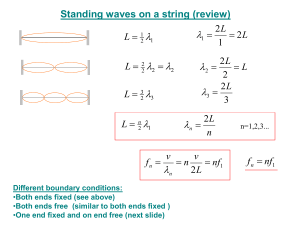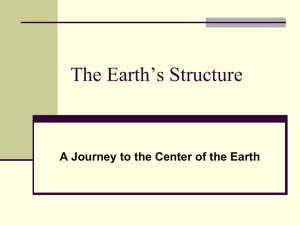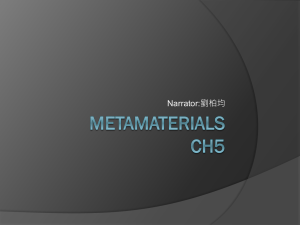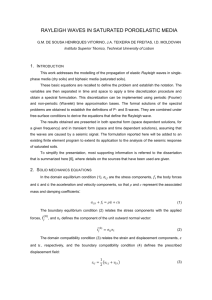Ground Motion Spectra
advertisement
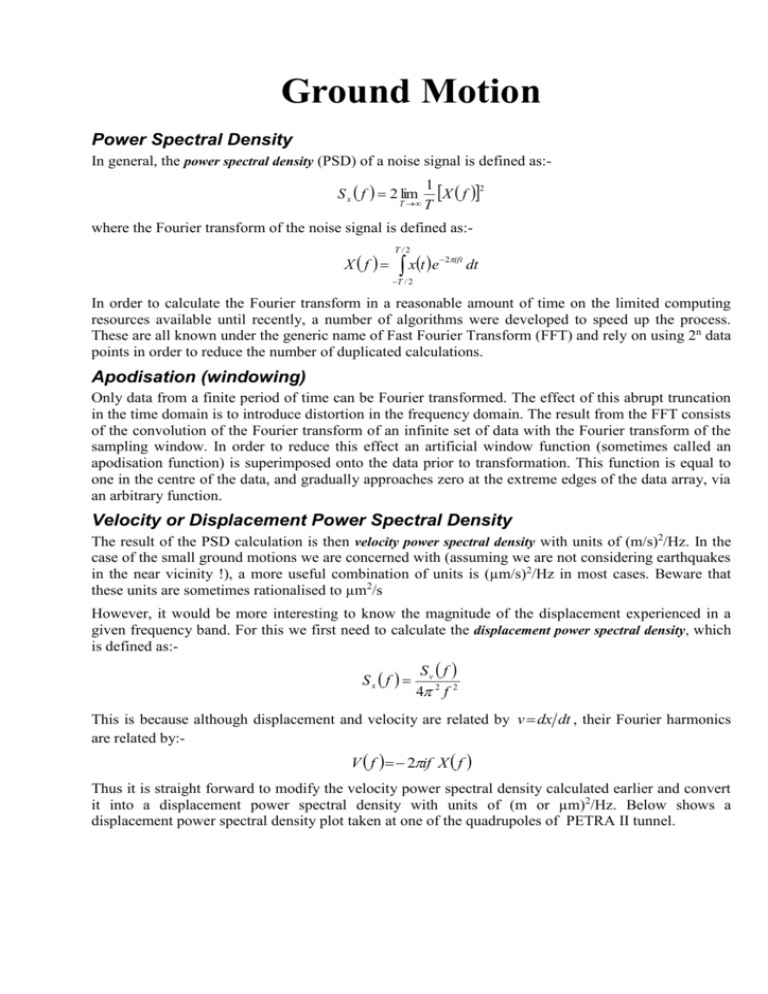
Ground Motion Power Spectral Density In general, the power spectral density (PSD) of a noise signal is defined as:S x f 2 lim T 1 X f 2 T where the Fourier transform of the noise signal is defined as:T /2 X f xt e 2ift dt T / 2 In order to calculate the Fourier transform in a reasonable amount of time on the limited computing resources available until recently, a number of algorithms were developed to speed up the process. These are all known under the generic name of Fast Fourier Transform (FFT) and rely on using 2n data points in order to reduce the number of duplicated calculations. Apodisation (windowing) Only data from a finite period of time can be Fourier transformed. The effect of this abrupt truncation in the time domain is to introduce distortion in the frequency domain. The result from the FFT consists of the convolution of the Fourier transform of an infinite set of data with the Fourier transform of the sampling window. In order to reduce this effect an artificial window function (sometimes called an apodisation function) is superimposed onto the data prior to transformation. This function is equal to one in the centre of the data, and gradually approaches zero at the extreme edges of the data array, via an arbitrary function. Velocity or Displacement Power Spectral Density The result of the PSD calculation is then velocity power spectral density with units of (m/s)2/Hz. In the case of the small ground motions we are concerned with (assuming we are not considering earthquakes in the near vicinity !), a more useful combination of units is (µm/s)2/Hz in most cases. Beware that these units are sometimes rationalised to µm2/s However, it would be more interesting to know the magnitude of the displacement experienced in a given frequency band. For this we first need to calculate the displacement power spectral density, which is defined as:- Sx f Sv f 4 2 f 2 This is because although displacement and velocity are related by v dx dt , their Fourier harmonics are related by:- V f 2if X f Thus it is straight forward to modify the velocity power spectral density calculated earlier and convert it into a displacement power spectral density with units of (m or µm)2/Hz. Below shows a displacement power spectral density plot taken at one of the quadrupoles of PETRA II tunnel. psd (um^2/Hz) Ground Motion 1.00E-01 1.00E-02 1.00E-03 1.00E-04 1.00E-05 1.00E-06 1.00E-07 1.00E-08 1.00E-09 1.00E-10 1.00E-11 Q2NBQ psd1 Q2NBQ psd2 0.1 1 10 100 1000 Frequency (Hz) In order to smooth out some of the noise that is visible in such spectra, so that the real features are clearly visible, it is advantageous to average a number of spectra. These must be over the same frequency range and with the same sampling interval. The example spectra shown here have already been smoothed in this way; data is normally collected for longer than is required to attain the lower frequency limit of the device anyway. The displacement power spectral density is particularly useful, because it allows you to calculate the total rms displacement in any frequency band (or indeed over the whole frequency range measured) by integrating the displacement PSD and taking the square root:z rms f 1 , f 2 f2 S f df x f1 Ground Vibration Integrated Displacements (nm) 140 120 100 80 60 40 20 0 0.1 1 10 Frequency (Hz) 100 Coherence and Correlation Crudely speaking, if all the quadrupoles in a storage ring move together then there is no impact on the beam. This would be the case if the wavelength of the ground motion was significantly bigger than diameter of the ring, or if the vibration was coherent over the ring dimensions. The property of coherence between the motion detected at two different measurement points is defined by first calculating the normalised cross-correlation function:- X f Y * f K f X f X * f Y f Y * f Where X f and Y f are the Fourier transforms of two signals as previously defined, Xf T /2 xt e 2ift dt and Y f T / 2 T /2 yt e 2ift dt , the brackets are intended to indicate an T / 2 average over several sets of measurement, and the * indicates the complex conjugate. The real part of the normalised cross-correlation function is called the correlation and the modulus the coherence. The value of the coherence can have a maximum value of one, implying that the two signals have a constant phase relationship. Conversely, a coherence of close to zero implies very little correlation (in the non-mathematical sense) between the signals. Certain oscillations that can be detected, due to waves in the Earth's crust, show significant coherence on scales comparable or larger then typical storage ring dimensions. Ground Motion Q2NBQ 1 Coherence 0.8 0.6 0.4 0.2 0 0.1 1 10 100 Frequency (Hz) Wave Propagation Before interpreting a typical ground motion power spectral density spectrum, it is useful to understand some of the properties of seismic waves. These can be split into two groups; body waves which travel in any direction through the Earth in two forms: P-waves are simple compression (longitudinal) waves, S-waves are transverse waves in which the rock undergoes shear displacements perpendicular to the direction of propagation of the wave. Surface waves can only propagate on the surface of the Earth's crust; two important types are: Love waves are like horizontal S-waves except the amplitude decreases with increasing depth, Rayleigh waves are similar to ocean waves in that any point on the medium through which the wave is travelling describes an ellipse as the wave passes. A good depiction of these wave types can be seen in ref. 1. The velocity of the waves is determined by the bulk modulus K (the change in volume against pressure) or the rigidity modulus µ (the angular deformation against shear force) and the density ρ of the rock. The velocity of a P-wave is: 4 C p K 3 while the velocity of a S-wave is:Cs Because K is always positive, Cp is always greater than Cs. Note that the bulk and rigidity moduli can be converted into the more familiar Poissons's Ratio σ:- 3K 2 6 K 2 and Young's Modulus:Y 9 K 3K 1 2 2 1 3K Ground Motion Spectra Tidal Motion The largest external force applied to the Earth is that due to its proximity to the sun and the moon. This results in a tidal deformation, analogous to, but one-third smaller than that experienced by the oceans. Due to the fact that there are two perturbing bodies, following elliptical orbits relative to the Earth, one of which is inclined to the other, a complicated spectrum of eleven major and many minor components arises. The fundamental has a period of approximately 44 ks (or a frequency of 22.6 µHz) with a peakto-peak amplitude of up to 0.57 m relative to the centre of the Earth. Such tidal deformations of the Earth's crust are also affected significantly by local weather. Variability in the length of the day and also the wobble in the Earth's axis of rotation relative to its surface add other uncertainties. See ref. 2 for an interesting treatment. Microseismic Peak Irrespective of the location of the measurement, displacement power spectral density plots always show a distinct peak with maximum amplitude at frequencies in the range of 0.1 up to 0.25 Hz (i.e. period ≈ 7 s). This is known as the microseismic peak and is due to the action of the coastal waves on the land. Due to the small degree of attenuation suffered by these waves they can be detected even in the centre of continents. The feature usually consists of two peaks, the lower frequency coinciding with the frequency of the ocean swell, while the second, larger, peak, at about twice the frequency, due to coupling of the oceanic swell with a standing wave in the continental shelf, which then propagates across the continent. The frequency and amplitude of both of these peaks increases with storm activity at sea. Recording the angular distribution of the signal amplitude detected at this frequency allows the geographical sources of this signal to be determined, for example in ref. 4. High and low amplitude long term averaged spectra for comparison with measurements are available. Crustal Resonance At around a frequency of 2.5 Hz, a broad peak appears which is due to crustal resonances; this is the "ringing" of the Earth's crust, driven by the motion of the tectonic plates of the crust. These standing waves are most noticeable following an earthquake when the Earth has been described as "ringing like a bell" ! The difference in the arrival time of wavefronts produced by earthquakes (or for that matter underground nuclear explosions) allows the position of the event to be determined. The P- and Swaves pass throught the body of the Earth at different speeds, as do the surface waves as they propagate around the Earth's crust, all arriving at the detection point(s) at different times. Technical Noise and Cultural Noise The region of the spectrum from a few Hertz up to one hundred Hertz is the most important region for accelerator operators. Most sources of ground vibration can be divided into one of these two categories. Technical Noise is an expression coined by the Russians to encompass noise generated by the operation of the accelerator facility itself. Examples of sources are: Electric motors (compressors, workshops, etc.) Pumps (cooling water flows etc.) Crane activity Site traffic People walking about. Cultural Noise includes other human generated vibration noise that does emanate from the site itself but from outside, and is thus outside the control of the accelerator operators. Examples of such sources are: Traffic on roads near the site (ESRF had a particular problem with passing lorries that required the replacement of some access covers on an adjacent road.) Railways Industry Ground Motion due to Aeroplanes One unexpected source of low frequency ground motion is passing aeroplanes. Measurements at HERA [ref 4] noted a 4 µm depression in the surface due to the passing of an aeroplane approximately 500 m directly overhead ! There was no corresponding motion in the HERA tunnel. In fact the HERA team claim a 70 % success rate in detecting over-flying aeroplanes based on ground displacement measurements only. This is one example of how atmospheric phenomena can cause changes on the surface of the Earth. Normal changes in barometric pressure, precipitation and wind can all cause significant ground motion effects that cannot be neglected The ATL LAW An alternative method for analysing some components of low frequency ground motion over long time intervals makes use of the so called "ATL law". It is used to describe the diffusive or Brownian motion that unconnected points on the ground (or structures attached to the ground) undergo which is uncorrelated and acts as a low intensity baseline to the regular (in time and space) motion due to propagating waves in the upper Earth's crust. According to the ATL law, the relative motion of two points scales as the product of the spatial and temporal interval between measurements. This empirical rule gives the rms relative displacement dX of two points separated by a distance L and time T as:dX 2 ATL Where the constant A is of the order of 10 51 m 2 / sm , depending on conditions at the site. This corresponds to a power spectral density of :AL S ATL f , for f 0 2 2 f 2 This law is particularly useful for modelling the slow degeneration in the alignment of magnets in the accelerator which leads to the periodic need for realignment. Effect on Accelerator structures The ratio of the magnitude of a quadrupole's motion in a strong focussing machine lattice to that of the resultant electron beam motion can be ten or more. This amplification factor is the reason why ground motion is of particular interest to accelerator builders. For collider designs, the requirement to achieve a high luminosity at the interaction point with two very low emittance beams places the most stringent restrictions on ground motion. For a synchrotron radiation source, the spatial stability of the photon beams is the critical parameter. Diffusive Drift of Components Following a period of settlement due to construction work etc., it is possible to model the diffusive motion of the lattice magnets using the ATL law. This "random walk" of the magnets must be corrected by periodic survey and realignment techniques. Higher Frequency Motion The effect of waves propagating through the ground on circular accelerators is determined by the relative circumference of the ring to the wavelength. Obviously, if all the quadrupoles move coherently (i.e. the wavelength is large compared to the diameter) then relative motion of the quadrupoles is suppressed and the impact on alignment less significant. Taking PETRA III as an example, the diameter of the accelerator is approximately 367 m. Thus ground waves with wavelengths of more than 734 m will not be a problem. This means that the low frequency limit, below which the lattice will move coherently, is about 1.5 Hz. Above this limit particularly important frequencies exist that give ground wavelengths that are the same as the betatron wavelengths and therefore cause resonant beam excitations. PETRA III lattice currently under consideration feature horizontal and vertical tunes, Qx and Qy, of approximately 36.095 and 31.345 respectively, or wavelengths of 64 and 73.5 m. Resonant Amplification by Magnet Structures Even if the levels of ground motion are within acceptable limits, it is quite easy to design magnet supports that will amplify the ground motion by a factor of ten by behaving in a resonant manner. This is most likely to be a problem in the 5 to 35 Hz range. Control options include pushing the resonant frequency of the magnet support out of the critical frequency band, or by damping the oscillation to reduce the amplitude of the resonance (see below). Countermeasures Prevention is still better than cure. Therefore the following steps must be taken:1. Design machines with parameters and lattices that are less sensitive to position errors. 2. Choose a site where natural and man-made disturbances are minimised (Try to choose a site on scientific and technical grounds and not political ones). 3. Undertake careful design of building structure and foundations. 4. Undertake careful design and modelling of all magnet support structures. Use FEA to predict resonant frequencies of all magnet structures and modify as appropriate. 5. Do not spoil a good site by carelessly introducing sources of vibration from reciprocating pumps, cooling water etc., as well as maintaining constant temperatures with small gradients around sensitive components. However, if all of these measures fail then the following countermeasures can be taken:1. Periodic survey and alignment of lattice magnets. It is possible to calculate the amount of diffusive motion of the lattice magnets that can be expected (after their initial settlement). Given a judgement of an acceptable period between realignment campaigns it is then possible to calculate the likely steering corrector strengths required. Note that this will tell you the levels of correction necessary to get the beam back through the centre of the quadrupoles; it does not mean that the beam is following the initial trajectory. 2. Vibration isolation. This is possible for driving frequencies some way above the resonant frequency of the structure, but requires structures with very soft spring constants in the region of the resonance. 3. Vibration damping. This technique relies on coupling the resonating structure to an object (say, for example, the floor) that is not resonating at that frequency via a material with very specific anisotropy in its properties. Unfortunately the properties of these damping materials are usually highly dependant on temperature and stress. An example of the application of this technique at the ESRF is given in Ref 7. 4. Dynamic alignment. This is requires a source of misalignment information (possibly from 5. below) plus a motorised realignment mechanism to position the most crucial magnets back to a better aligned position. The frequency range over which this would be expected to work would need careful consideration. 5. Beam-based feedback. If all else fails, then some form of beam-based feedback can be used to overcome a certain amount of positional instability of the magnets, over frequency ranges that need to be defined. Home page of Orbit Movement and Beam Position Control

